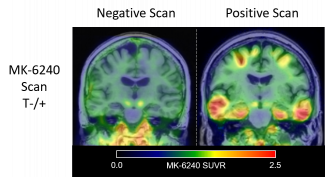
Scientists within the Wisconsin Alzheimer’s Disease Research Center and internationally have found evidence that tau PET (positron emission tomography) scans are highly specific to Alzheimer’s disease. In a study published in December 2019, Tobey Betthauser, PhD, concluded that the presence of both amyloid and tau protein deposits are associated with cognitive decline during the preclinical phase of Alzheimer’s disease. Similarly, a study led by Oskar Hansson of Skåne University Hospital in Sweden and published this May in JAMA Neurology found that tau tracer RO-948 was highly specific for detection of Alzheimer’s disease.
Betthauser provided comment to a recent Alzforum newsletter that highlighted the Swedish study: “This study presents a tremendous step forward for understanding the clinical and research utility of RO-948 and tau PET imaging.”
In that study—which evaluated 613 participants with an average age of 69—nearly every person with a positive tau PET scan (indicating increased tau proteins) also had amyloid plaques, though not every person with increased amyloid also had positive tau scans. This corroborates Betthauser’s December study published in BRAIN, and indicates that tau PET scans are highly specific to Alzheimer’s disease and are likely more proximal to cognitive impairment than amyloid deposits.
When the tau PET results were compared to cerebral spinal fluid biomarkers, both tests were highly sensitive to cognitive disorders, but the tau tracer RO-948 was best able to differentiate between dementia due to Alzheimer’s disease and both unimpaired controls and non-Alzheimer’s dementias. In the future, the specificity of tau tracers to Alzheimer’s disease could allow researchers to pinpoint the source of a patient’s cognitive decline. Notably, the first ever tau PET imaging tracer Tauvid (formerly Flortaucipir, AV1451, T807) was approved by the FDA to aid in the diagnosis of Alzheimer’s disease, but appropriate use criteria are yet to be established.
“The Wisconsin Alzheimer’s Disease Research Center was one of the first centers to study tau tracers using PET scans,” Betthauser says. “We’re encouraged to see the similarities between tau PET tracers in regard to their specificity to Alzheimer’s disease.”
Article by Tyler Fox
- Log in to post comments



